MicroStrategy ONE
Defining how a prompt is displayed in MicroStrategy Web
You can determine how a prompt appears when it is executed in MicroStrategy Web, by selecting a display style, and then updating the style properties associated with it.
For "Choose from All Attributes in a Hierarchy," "Qualify on an Attribute," and "Qualify on a Metric" prompts, you can also configure how the user can define the attribute or metric qualification in the prompt when the prompt is executed in MicroStrategy Web.
To define how a prompt is displayed in MicroStrategy Web
This procedure assumes that you are creating a new prompt or modifying an existing prompt, and that you have accessed the Web Options dialog box from the General Information page of the Prompt Generation Wizard. For instructions to create a prompt, see About prompts.
-
On the Web Options dialog box, select the Display Style. The type of prompt determines which display styles are available, as described in the following table:
Display Style
Available for
Check box
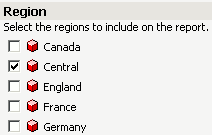
-
Attribute element list prompts
-
Object prompts
List
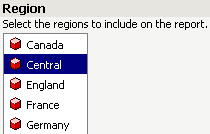
-
Attribute element list prompts
-
Attribute qualification prompts
-
Metric qualification prompts
-
Object prompts
Radio button
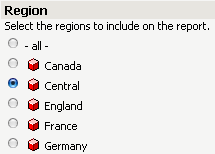
-
Attribute element list prompts
-
Attribute qualification prompts
-
Metric qualification prompts
-
Object prompts
Pull down
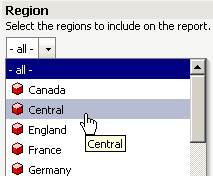
-
Attribute element list prompts
-
Attribute qualification prompts
-
Metric qualification prompts
-
Object prompts
Shopping cart
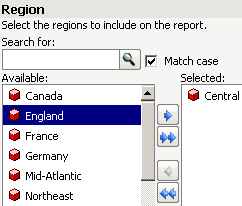
-
Attribute element list prompts
-
Attribute qualification prompts
-
Hierarchy prompts
-
Metric qualification prompts
-
Object prompts
In MicroStrategy Web, a user clicks an object to drill to the next level. The user hovers overs an object to highlight it, then double-clicks in the highlighted area to add the object to the Selected list.
Text box
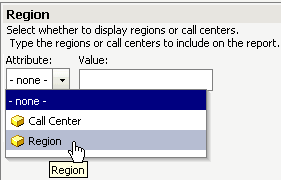
-
Attribute qualification prompts
-
Metric qualification prompts
-
Value prompts
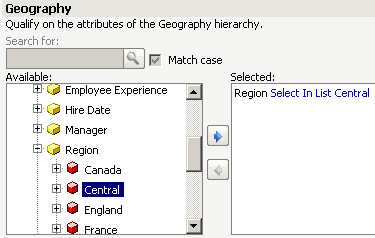
-
Hierarchy prompts
-
Object prompts
In MicroStrategy Web, a user expands the levels to navigate to an object. The user double-clicks an object to add it to the Selected list.
The type of prompt and the display style determine the style properties that are displayed; not all the properties in the following procedure will apply in every case.
-
-
If your project contains a custom prompt style that you want to use:
-
Select the Display Style associated with the custom style.
-
Select the Custom Style from the drop-down list.
-
-
You can select whether the user, when the prompt is executed, can change the logical operator (AND, OR, and so on) of a qualification. Select or clear the Allow modification of the logical operator check box.
-
The Allow modification of the logical operator check box is available for:
-
Attribute qualification prompts with the Shopping Cart display style
-
Hierarchy prompts with the Shopping Cart or Tree display style
-
Metric qualification prompts with the Shopping Cart display style
-
If Allow modification is selected, select one of the following options:
-
Use a single logical operator between all conditions: The user can select only one logical operator to join all the conditions of the prompt qualification.
-
Allow the user to set independent logical operators between conditions: The user can select different logical operators between each condition of the prompt qualification.
-
-
You can determine whether a search of possible prompt answers is allowed when the prompt is executed. Allowing searches is useful if the prompt contains many possible answers. It provides users who know what they want a quick way to find it, while those who do not can scroll through the list until they find what they want. Select or clear the Show search box check box.
-
The Show search box check box is available for:
-
Attribute element list prompts that list all the attribute elements
-
Attribute qualification prompts and metric qualification prompts that use search objects (all display styles except Text Box)
-
Hierarchy prompts
-
Object prompts that use search objects
-
-
For example, an attribute element list prompt lists regions. When the prompt is executed, a user can select from the list of regions, or type "north" in the search box to display only Northeast and Northwest in the list. This example is shown below on the left. For a hierarchy prompt, shown below on the right, the search box is not enabled until the user selects an attribute. In this example, the user selected Region, the search box was enabled, and the user typed "north". The search results are displayed at the bottom of the hierarchy list.
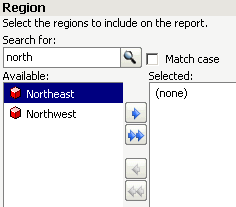
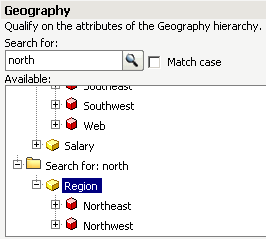
If the prompt is based on a search that contains a string, the search box is disabled when the prompt is executed.
-
-
You can determine whether the user must specify a search when he is browsing elements in a hierarchy prompt. If a search is not required, the elements are listed in the prompt. A search is useful if long lists of elements are possible. Select or clear the Require search check box.
You must enable Show search box for the Require search check box to become available.
-
The Require search check box is available for:
-
Hierarchy prompts for all display styles
For example, a prompt displays the attributes from the Geography hierarchy. When an attribute is clicked, the attribute elements are listed (for an example, see the Tree example in the table above). If a search is required, a search box is displayed instead of the attribute elements, as shown below:
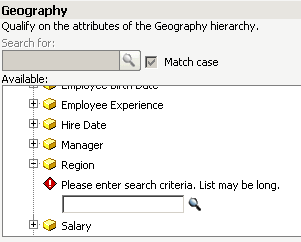
-
-
You can specify whether a user, when the prompt is executed, can navigate the hierarchy path above the search root, which is defined below. Select or clear the Allow navigation above the search root check box.
-
For a prompt that uses a search object in the prompt definition, the search root is the directory specified in the Look in field for the search.
-
For a prompt that does not use a search object but allows a search (the Show search box check box is selected), the search root is the project directory, for example, \MicroStrategy Tutorial.
-
The Allow navigation above the search root check box is available for:
-
Object prompts with the Shopping Cart display style or Tree display style
-
Hierarchy prompts with the Shopping Cart or Tree display style
-
-
-
You can specify whether a user, when the prompt is executed, can expand an attribute to select elements to answer the prompt. Select or clear the Allow the user to browse elements in a qualification check box.
-
The Allow the user to browse elements in a qualification check box is available for:
-
Attribute qualification prompts with all display styles
-
-
You can define the number of items to display in a column/row of the check box or radio button list. Type the number in the Items per column/row field.
-
The Items per column/row field is available for:
-
Attribute list prompts with Check Box or Radio button display style
-
Object prompts with the Check Box or Radio button display style
-
-
-
For the Check Box and Radio Button display styles, you can specify the Orientation, which is whether the check boxes or radio buttons are Horizontal (displayed on a single line from left to right) or Vertical (displayed in a single column).
-
Orientation is available for:
-
Attribute list prompts with Check Box or Radio button display style
-
Object prompts with the Check Box or Radio button display style
-
-
-
You can select the List height mode from the following options:
-
Automatically adjusts the height of the list to the height of its contents.
-
Fixed sets the height of the list to a specific height, as entered in the Height field.
-
The List height modeis available for all display styles except Pull Down and Text Box.
-
-
You can select the List width mode from the following options:
-
Automatically adjusts the width of the list or text box to the width of its contents.
-
Fixed sets the width of the list or text box to a specific width, as entered in the Width field.
For the Pull Down and Text Box styles, List width mode is displayed as Width mode.
The List width mode is available for all display styles.
For attribute qualification, metric qualification, and hierarchy prompts, you can configure how the user can define the attribute or metric qualification in the prompt when the prompt is executed. This configuration applies when the prompt is executed in MicroStrategy Web only. For examples of how these properties affect the display of the prompt in MicroStrategy Web, see the Advanced Reporting Help.
-
-
For attribute qualification and hierarchy prompts, select the type of expression that the user can create when the prompt is executed. The options in the Expression type allowed drop-down list are:
-
Select: When the prompt is executed, the user selects an attribute, and then creates a list of attribute elements to include in or omit from the report.
For example, the following prompt, which is being executed in MicroStrategy Web, allows the user to select the regions to include in the report:
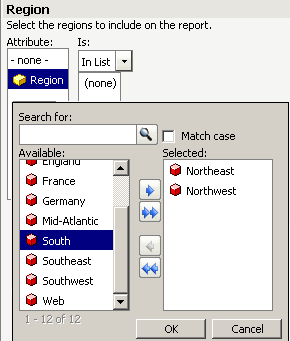
-
Qualify: When the prompt is executed, the user creates an attribute qualification to answer the prompt. The user selects an attribute, an attribute form (such as ID or Description), an operator (such as Contains or Begins with), and a value to compare the attribute element to.
For example, a MicroStrategy Web user can select Region, Description, Begins with, and north to include all northern regions in the report, as shown below:
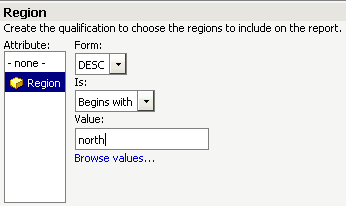
-
Select and Qualify: When the prompt is executed, the user chooses to either select attribute elements or create an attribute qualification, as described above.
For example, the following prompt, which is being executed in MicroStrategy Web, contains the radio buttons to select the expression type:
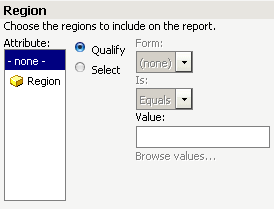
-
-
For attribute qualification and hierarchy prompts, if Select and Qualify is chosen as the Expression type allowed, set theDefault qualification type to either Select or Qualify. The user can change from this default when the prompt is executed.
-
For attribute qualification and hierarchy prompts, by default, the Allow import elements check box is cleared, which indicates that files cannot be imported. Select the check box to allow a user to load a file containing a list of elements for an In List or Not in List type of qualification. The file is loaded when the prompt is executed.
-
For metric qualification prompts, by default, the Display output level selection check box is selected, which indicates that the user can select an output level (metric level, report level, or a specific attribute) when the prompt is executed. Clear the check box to disable output level selection.
An output level is the level at which the metric is calculated. For background information on metric levels, see Modifying the context of calculations: Level metrics.
-
Select the Default operator (such as In List, Contains, Equals, or Greater Than) to use in the prompt's qualification. When the prompt is executed, the user can accept this default operator or select a different operator.
-
Choose either AND or OR as the Default operator between conditions in the prompt's definition. When the prompt is executed, the user can accept this default operator or select the other operator.
To enable multiple conditions, define the Minimum number of qualifications as a number larger than one.
For example, the following prompt, shown in MicroStrategy Web, allows multiple conditions. The user has created a condition on north and another on south. The AND operator was chosen as the default operator between conditions, so the All selections option is selected. This report would not return any results (a word cannot begin with both "north" and "south"), so the user can change the Match option to Any selection (representing the OR operator). The report will then return all northern and southern regions.
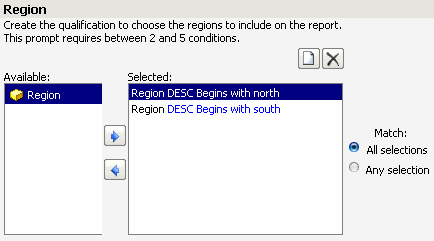
-
Click OK to return to the General Information page of the Prompt Generation Wizard.
-
If you are creating an attribute element list prompt, return to Steps to create a "Choose from an attribute element list" prompt.
-
If you are creating an attribute qualification prompt, return to Steps to create a "Qualify on an attribute" prompt .
-
If you are creating a hierarchy prompt, return to Steps to create a "Choose from all attributes in a hierarchy" prompt.
-
If you are creating a metric qualification prompt, return to Steps to create a "Qualify on a metric" prompt.
-
If you are creating an object prompt, return to Steps to create an object prompt.
-
If you are creating a value prompt, return to Steps to create a value prompt.
-
